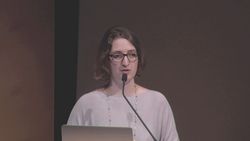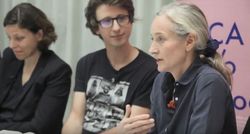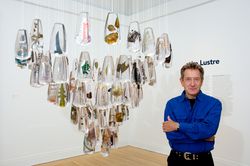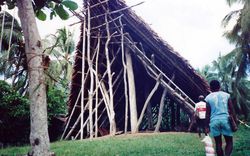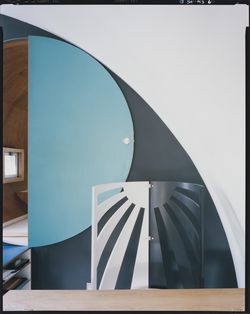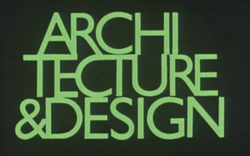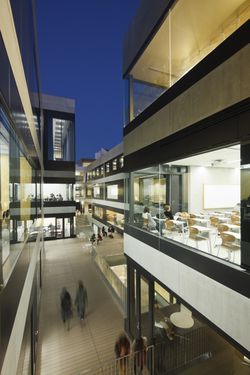archives
Niveau de description archivistique:
Fonds
Fonds Álvaro Siza
AP178
Description:
The Álvaro Siza fonds documents the architectural work of Portuguese architect Álvaro Siza. Records in this fonds document Siza’s projects from 1958-2012, including built and unbuilt designs. A collaborative project was established between the Canadian Centre for Architecture (CCA), Fundação de Serralves, and Fundação Calouste Gulbenkian to allow for international research and access to the archive. The archive is shared by the three institutions with each institution holding different projects while collaborating on the descriptive work and increasing the visibility of the archive. The holdings at both the Fundação de Serralves and Fundação Calouste Gulbenkian focus on Siza’s Portuguese projects, while the portion of the archive held by the CCA mainly includes Siza’s projects abroad. All three institutions are committed to describing the archive and making it accessible for scholarly research. The processing of the Siza archive held by the CCA has been divided into four phases to allow for access to parts of the archive while still in process. For the first, second, and third phases, the processing archivist has described the projects from the fifties, sixties, and seventies, as well as projects for the IBA competition in Berlin, urban renewal projects in The Hague from the eighties, urban plans, museums, and individual houses between 1980 and 2000. The processing archivist has also described approximately 203 sketchbooks. Many of these sketchbooks include sketches related to architectural projects which were processed. The complete list of projects processed by the CCA to date can be found in series AP178.S1. The bulk of the Álvaro Siza fonds is arranged in Series AP178.S1, which contains documentation for over 200 of Siza’s architectural projects. Records in this archive are predominantly from 1970 to 2000. Series AP178.S1 mainly contains conceptual, design development, presentation, and working drawings. Also included are photographic materials, models, born digital records, and textual documentation, which include correspondence, project proposals, and notes. The architect’s creative process is captured in 282 sketchbooks arranged in Series AP178.S2. In all there are approximately 60 000 drawings, 3000 folders of textual documentation, 9.46 linear meters of photographs and negatives, 6,545 slides, 250 CD-ROMS, 101 floppy disks, and 371 models that document the architectural activities of Siza and his office. Among the drawings are sketches by Siza on various items, such as napkins, receipts, envelopes, or on the back of working drawings. The fonds contains several types of architectural projects including residential buildings, museums, universities, urban plans, offices, and city restorations. Of particular significance are the sketchbooks, comprised of sketches for architectural projects, Siza’s travels, people, and animals as well as notes and draft letters. The sketchbooks are organized in chronological order, starting in the late 1970’s to the beginning of the 2000’s. Locations, notes, and dates have also been identified on the front of each sketchbook along with the sketchbook number. The sketchbooks provide a unique perspective of Siza’s use of drawing as part of his work process.
1958-2002
Fonds Álvaro Siza
Actions:
AP178
Description:
The Álvaro Siza fonds documents the architectural work of Portuguese architect Álvaro Siza. Records in this fonds document Siza’s projects from 1958-2012, including built and unbuilt designs. A collaborative project was established between the Canadian Centre for Architecture (CCA), Fundação de Serralves, and Fundação Calouste Gulbenkian to allow for international research and access to the archive. The archive is shared by the three institutions with each institution holding different projects while collaborating on the descriptive work and increasing the visibility of the archive. The holdings at both the Fundação de Serralves and Fundação Calouste Gulbenkian focus on Siza’s Portuguese projects, while the portion of the archive held by the CCA mainly includes Siza’s projects abroad. All three institutions are committed to describing the archive and making it accessible for scholarly research. The processing of the Siza archive held by the CCA has been divided into four phases to allow for access to parts of the archive while still in process. For the first, second, and third phases, the processing archivist has described the projects from the fifties, sixties, and seventies, as well as projects for the IBA competition in Berlin, urban renewal projects in The Hague from the eighties, urban plans, museums, and individual houses between 1980 and 2000. The processing archivist has also described approximately 203 sketchbooks. Many of these sketchbooks include sketches related to architectural projects which were processed. The complete list of projects processed by the CCA to date can be found in series AP178.S1. The bulk of the Álvaro Siza fonds is arranged in Series AP178.S1, which contains documentation for over 200 of Siza’s architectural projects. Records in this archive are predominantly from 1970 to 2000. Series AP178.S1 mainly contains conceptual, design development, presentation, and working drawings. Also included are photographic materials, models, born digital records, and textual documentation, which include correspondence, project proposals, and notes. The architect’s creative process is captured in 282 sketchbooks arranged in Series AP178.S2. In all there are approximately 60 000 drawings, 3000 folders of textual documentation, 9.46 linear meters of photographs and negatives, 6,545 slides, 250 CD-ROMS, 101 floppy disks, and 371 models that document the architectural activities of Siza and his office. Among the drawings are sketches by Siza on various items, such as napkins, receipts, envelopes, or on the back of working drawings. The fonds contains several types of architectural projects including residential buildings, museums, universities, urban plans, offices, and city restorations. Of particular significance are the sketchbooks, comprised of sketches for architectural projects, Siza’s travels, people, and animals as well as notes and draft letters. The sketchbooks are organized in chronological order, starting in the late 1970’s to the beginning of the 2000’s. Locations, notes, and dates have also been identified on the front of each sketchbook along with the sketchbook number. The sketchbooks provide a unique perspective of Siza’s use of drawing as part of his work process.
archives
Niveau de description archivistique:
Fonds
1958-2002
La veille du jour de l’An 1987, 4000 tonnes de cendres toxiques sont livrées aux habitants des Gonaïves, une ville portuaire démunie sur la côte occidentale d’Haïti. Dans un contexte politique instable, des fonctionnaires haïtiens ont autorisé l’importation de déchets toxiques des États-Unis, catégorisés comme des «fertilisants». Dans ce cas, la cendre provient de(...)
16 mars 2017
C’est toxique ici, mais pas là-bas
Actions:
Description:
La veille du jour de l’An 1987, 4000 tonnes de cendres toxiques sont livrées aux habitants des Gonaïves, une ville portuaire démunie sur la côte occidentale d’Haïti. Dans un contexte politique instable, des fonctionnaires haïtiens ont autorisé l’importation de déchets toxiques des États-Unis, catégorisés comme des «fertilisants». Dans ce cas, la cendre provient de(...)
Le CCA organise un après-midi de discussion à Lisbonne autour de l’œuvre de Cedric Price, à l’occasion de l’exposition Obra / Building Site, qui présente le projet McAppy de Price dans le cadre de la 4e Triennale de Lisbonne, intitulée The Form of Form, et de la publication de Cedric Price Works 1952–2003: A Forward-Minded Retrospective. Un lancement du livre suivra à(...)
Travessa do Cabo, 10-12. Lisbonne
22 octobre 2016
Un après-midi avec Cedric Price no 1
Actions:
Description:
Le CCA organise un après-midi de discussion à Lisbonne autour de l’œuvre de Cedric Price, à l’occasion de l’exposition Obra / Building Site, qui présente le projet McAppy de Price dans le cadre de la 4e Triennale de Lisbonne, intitulée The Form of Form, et de la publication de Cedric Price Works 1952–2003: A Forward-Minded Retrospective. Un lancement du livre suivra à(...)
Travessa do Cabo, 10-12. Lisbonne
Gilles Clément
Dans le cadre de l’exposition Environnement : manières d’agir pour demain (2006), l’ingénieur horticole et paysagiste français Gilles Clément présente ses projets et ses théories. L’exposition propose un changement de perspective où l’environnement devient le point de départ d’une réflexion et non nos exigences d’humains envers ce dernier. Gilles Clément a réalisé de(...)
Théâtre Paul-Desmarais
19 octobre 2006
Gilles Clément
Actions:
Description:
Dans le cadre de l’exposition Environnement : manières d’agir pour demain (2006), l’ingénieur horticole et paysagiste français Gilles Clément présente ses projets et ses théories. L’exposition propose un changement de perspective où l’environnement devient le point de départ d’une réflexion et non nos exigences d’humains envers ce dernier. Gilles Clément a réalisé de(...)
Théâtre Paul-Desmarais
archives
Niveau de description archivistique:
Fonds
AP075
Résumé:
The Cornelia Hahn Oberlander fonds documents Oberlander's professional activities as a landscape architect. It contains over 203 projects that span from 1950 to 2018 predominantly in Canada and in the United States, but also in Germany. The fonds is a complete record of Oberlander's work, and comprises her playground projects, roof gardens, and public space landscapes, as well as landscape designs for private residences, as well as administrative records from her practice, her professional engagements, and her research materials. The material in this fonds is dated from 1936 to 2021.
1936-2021
Fonds Cornelia Hahn Oberlander
Actions:
AP075
Résumé:
The Cornelia Hahn Oberlander fonds documents Oberlander's professional activities as a landscape architect. It contains over 203 projects that span from 1950 to 2018 predominantly in Canada and in the United States, but also in Germany. The fonds is a complete record of Oberlander's work, and comprises her playground projects, roof gardens, and public space landscapes, as well as landscape designs for private residences, as well as administrative records from her practice, her professional engagements, and her research materials. The material in this fonds is dated from 1936 to 2021.
archives
Niveau de description archivistique:
Fonds
1936-2021
archives
Niveau de description archivistique:
Fonds
AP176
Résumé:
Karl Chu X PHYLUM project records, 1998-2014 (predominant 1998-2002), documents the development and design process of Chu’s project X PHYLUM. The archive consists exclusively of original born-digital material.
1998-2014
Documents d’archives de Karl Chu pour le projet X Phylum
Actions:
AP176
Résumé:
Karl Chu X PHYLUM project records, 1998-2014 (predominant 1998-2002), documents the development and design process of Chu’s project X PHYLUM. The archive consists exclusively of original born-digital material.
archives
Niveau de description archivistique:
Fonds
1998-2014
articles
L’intérieur sensoriel
Autres sens, autres espaces
Figure ayant profondément marqué l’architecture d’après-guerre au Japon, Kazuo Shinohara s’est surtout fait connaître pour ses maisons individuelles. Or il reste peu étudié de nos jours, particulièrement à l’extérieur du Japon. Il a joint certaines formes traditionnelles et l’exploration de principes modernistes au moment des technologies de pointe et de l’information(...)
21 septembre 2017, 18h30
David B. Stewart, quel sens avait l’histoire pour Kazuo Shinohara?
Actions:
Description:
Figure ayant profondément marqué l’architecture d’après-guerre au Japon, Kazuo Shinohara s’est surtout fait connaître pour ses maisons individuelles. Or il reste peu étudié de nos jours, particulièrement à l’extérieur du Japon. Il a joint certaines formes traditionnelles et l’exploration de principes modernistes au moment des technologies de pointe et de l’information(...)
articles
Dans cette causerie intitulée « Design the place for people to meet » (Concevoir le lieu pour que les gens se rencontrent), Manabu Chiba expliquera sa démarche de conception, soulignant la réalisation d’une architecture qui favorise les nouvelles interactions de lieu à lieu, de personne à personne et de personne à lieu. Son travail vise à révéler le contexte d’un(...)
11 février 2016
Manabu Chiba veut vous parler
Actions:
Description:
Dans cette causerie intitulée « Design the place for people to meet » (Concevoir le lieu pour que les gens se rencontrent), Manabu Chiba expliquera sa démarche de conception, soulignant la réalisation d’une architecture qui favorise les nouvelles interactions de lieu à lieu, de personne à personne et de personne à lieu. Son travail vise à révéler le contexte d’un(...)
